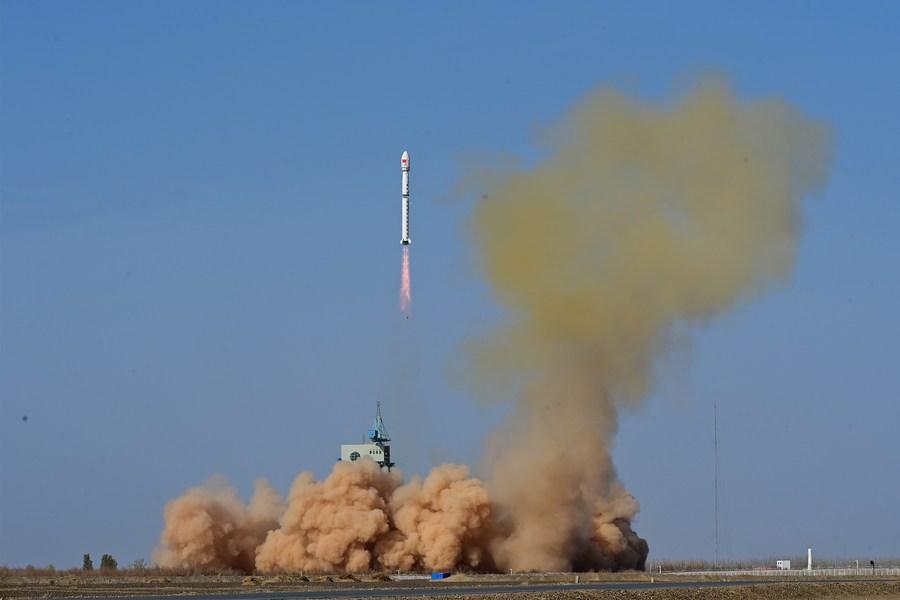Dubbed "the satellites closest to the people's daily lives,” China's homegrown Fengyun meteorological satellites monitor meteorological conditions on the planet 24/7, making important contributions to global disaster prevention and mitigation efforts.
Since the launch of China's first meteorological satellite in 1988, the country has successfully sent 21 Fengyun meteorological satellites of two generations into space. Nine of them are currently in orbit, providing data and products for 129 countries and regions around the world.

A Long March-4B rocket carrying the Fengyun-3 07 satellite blasts off from the Jiuquan Satellite Launch Center in northwest China, April 16, 2023. (Photo by Wang Jiangbo/Xinhua)
From simply "taking photos" of the atmosphere to "performing computed tomography (CT) scans" of the atmosphere, Fengyun satellites have evolved from lagging behind internationally to running alongside, and even leading the way in some areas.
China is the only country in the world that operates four near-Earth orbit meteorological satellites simultaneously—covering dawn, morning, afternoon, and oblique orbits.
With multiple satellites in orbit conducting networked observations, the country's Fengyun meteorological satellites are able to provide three dimensional, quantitative, global, all-weather, all-day, hyper-spectral, and timely precision monitoring data. They have become the backbone of the global network of Earth observation satellites.
Fengyun satellites are widely applied in such fields as weather forecasting, climate prediction, natural disaster and environmental monitoring, scientific research, and various industries including meteorology, oceanography, agriculture, forestry, water conservancy, transportation, aviation and aerospace.
They have contributed significantly to disaster prevention, climate change response and sustainable economic and social development.
In July 2023, after Typhoon Doksuri was formed in the northwest Pacific Ocean, Fengyun satellites monitored the typhoon throughout its life cycle, providing strong support to decision making at thematic consultations on the typhoon and rainstorms, as well as the accurate monitoring of extremely heavy rainfall triggered by the typhoon.
In recent years, data obtained from instruments on the Fengyun meteorological satellites have been playing an increasingly important role in the data assimilation of the numerical weather prediction models of the European Centre for Medium-Range Weather Forecasts (ECMWF), according to Niels Bormann, a Principal Scientist in the ECMWF Research Department.
In the past few years, Fengyun meteorological satellites have been used to monitor extreme drought events in Central Asia and facilitate studies on drought mechanisms, climate change and its impacts, identify affected areas, and then help these areas reduce adverse impacts and enhance climate resilience, said Sanjarbek Muratov, the Food and Agriculture Organization (FAO) representative to Uzbekistan.
In November 2023, the China Meteorological Administration (CMA) launched the international version of FengYun Earth, a Fengyun meteorological satellite-based platform, to provide customized services to international users.
The platform satisfies the specific requirements of users by providing more than 100 products in five categories covering cloud pictures, key elements, disaster events, climate, and model verification.
In an effort to better serve international users, the CMA established an emergency support mechanism on disaster prevention and mitigation for international users of Fengyun satellites in April 2018. A total of 34 countries had registered for the mechanism by 2023.
Since 2023, Fengyun satellites have responded 28 times to global demands for emergency support services. They have observed tropical cyclones Lola and Mocha, providing meteorological support to countries like Solomon Islands, Vanuatu, and Bangladesh.
The satellites have also helped monitor concentrated ignition points of devastating forest fires from the northern coast of Algeria to northwest Tunisia, offering important assistance for the fire prevention and control efforts of local authorities.
Over the past five years, the CMA has trained more than 1,000 international users to better use the products of Fengyun meteorological satellites, and provided support for the application software for Fengyun satellites' remote sensing services, and held video consultations on relevant services and products for over 20 countries and regions more than 50 times, according to statistics from the CMA.
The "circle of friends' of Fengyun satellites will be further expanded through international cooperation and multilateral and bilateral exchanges, reliable sources said.
China's National Satellite Meteorological Center (NSMC) is going to deepen international market research for Fengyun satellites, actively take part in international exchanges with foreign counterparts, and enhance international cooperation with other operators of meteorological satellites, said Wang Jingsong, director general of the NSMC.
"We will work with our international peers to further advance sci-tech innovations for Fengyun satellites to better serve global disaster prevention and mitigation efforts, jointly build a community with a shared future for mankind, and contribute Chinese solutions to the goal of the sustainable development of human society," he noted.
Category
China's Fengyun Meteorological Satellites Contribute to Global Disaster Prevention, Mitigation
Contributor
China's Fengyun Meteorological Satellites Contribute to Global Disaster Prevention, Mitigation
Country
Technical Solution

